Drone Regulations
Drones provide a magical view of the world from above, yet the joys of flight must be coupled with adherence to drone regulations related to Rollins Pass.

The Rollins Pass (Corona Pass) Road Status page as well as the Rollins Pass Maps page provide information on where motorized vehicles can and cannot drive on the pass and what current conditions look like. This page is similar: it provides information on flying drones on/near Rollins Pass. While it may not be updated as often as the road status page, it does provide links to content that are always up-to-date. Drones or unmanned aerial systems (UAS) provide a magical view of the world from above, yet the joys of flight and flying a drone need to be coupled with adherence to regulations set forth by both the US Forest Service (USFS) and the Federal Aviation Administration (FAA). The guidance provided below comes from multiple sources, including the USFS and the FAA. This page is not meant to be comprehensive, and you should always consult all official sources before launching your drone anywhere in the United States.
Pro Tip: While drones have advanced cameras and amazing flight capabilities, they also have significant drawbacks: no situational awareness of active incidents such as nearby TFRs, wildfires, and wilderness boundaries.
Do not rely on your drone to tell you if you are allowed to fly at a particular location or in a specific area. Merely having updated drone firmware and connecting via your cellphone does not automatically grant you permission to fly in a particular location. Many people mistakenly assume that if the propellers start spinning and the drone takes off, it’s automatically permissible to fly there—this is incorrect as well as potentially unsafe. The drone software lacks the ability to consider real-time developments like breaking news, VIP movements, wildfires, and other dynamic restrictions that can undergo changes on a daily or even hourly basis. For example, did you know that if there is a 30 nautical mile TFR established over the City of Boulder that you cannot fly your drone anywhere on Rollins Pass or even in Winter Park or Fraser?
So what should you do? How do you know if both the location and airspace are good so that you can fly confidently?
Use Aloft Air Control (available for iOS, Android, as well as a stand-alone web application) or the Air Aware app (iOS, Android, or web app) before taking off to ensure the airspace isn’t closed by a TFR, wilderness, or for other reasons. It is your responsibility to safely and compliantly fly your drone for the benefit of continued access with drones in the national airspace.
KNOW WHAT YOU NEED
In the event you are “ramp checked” by law enforcement or by an aviation safety inspector from the FAA, you will need your driver’s license, Remote Pilot certificate (and proof of a recurrent exam within the past 24 months) or the TRUST certificate if flying recreationally, your aircraft’s registration printout, any airspace authorizations and/or waivers, including any OOP or BVLOS paperwork. Your UAS will also need to be displaying its FAA registration number on the outside of the drone. The drone will also need either an external Remote ID broadcast module or broadcasting standard Remote ID as there are no FRIAs on or near Rollins Pass. Also having a preflight checklist is a good idea to prove compliance with §107.15. Questions? Contact the FAA UAS Support Center at: 844-FLY-MY-UA
INFORMATION ON REMOTE ID
Operators who do not comply with Remote ID could face fines and suspension or revocation of their drone pilot certificates.
Remote ID applies to drones which are required to be registered or have been registered with the FAA, including those flown for recreation, business, or public safety, and drones that are foreign-registered.
Why is Remote ID necessary?
Remote ID is necessary to ensure the safety and security of the national airspace system by distinguishing compliant airspace users from those potentially posing a safety or security risk. Remote ID also helps to lay the foundation for routine advanced operations such as package delivery and flying beyond visual line of sight.
What do I need to do?
There are three ways to comply with Remote ID:
1. Operate a Standard Remote ID Drone – a drone produced with built-in Remote ID broadcast capabilities; or
2. Operate a Drone with a Remote ID Broadcast Module – a device with Remote ID broadcast capabilities that can be attached to a drone; or
3. Operate at an FAA-Recognized Identification Area (FRIA) – areas where drones without Remote ID broadcast capabilities can operate.
How do I know if my drone or broadcast module is Remote ID compliant?
1. Go to the FAA UAS Declaration of Compliance website
2. Click on “View Public DOC List”
3. Filter by “RID” and “Accepted”
4. Search for your drone or broadcast module
My FAA-registered drone or broadcast module broadcasts Remote ID but is not on the Public DOC List, am I Remote ID compliant?
No, even if advertised as “Remote ID ready” or uses other verbiage, only drones or broadcast modules listed on the FAA DOC are in compliance with the rule.
Do I need to update my drone’s registration with Remote ID information?
If your drone or broadcast module is listed on the public DOC list, you need to register or update your existing drone registration through FAADroneZone to include the standard Remote ID drone or Remote ID broadcast module serial number. The Remote ID serial number is not the same as your drone’s serial number. Drone owners should check with their manufacturer for additional information.
Since recreational pilots only need to register once and can apply that registration number to multiple aircraft, they can list one Remote ID broadcast module serial number and move the broadcast module from drone to drone as long as it is listed on the same registration.
Part 107 pilots need to register each drone individually. Therefore, each drone must have its own Standard Remote ID or Remote ID broadcast module serial number.
Visit the FAA’s Remote ID webpage to learn more about adding a Remote ID serial number to your drone’s registration.
KNOW IF AND WHERE YOU CAN FLY
DRONE LAWS IN COLORADO
We recommend viewing this crowd-sourced page on Pilot Institute.
FAA UAS DATA
Click here for a map of FAA UAS Data and information on getting started with drones.
WILDLIFE
Wildlife can be easily spooked by a drone. Remember, if an animal changes its behavior, your drone is too close.
TFR
Never fly your UAS over or in close proximity to any fire operation (wildfire or prescribed/controlled burn). UAS flights over fire operations disrupt aerial firefighting operations and create hazardous situations. In fact, unauthorized UAS flights could lead fire managers and incident commanders to suspend aerial wildfire suppression operations until the UAS has left the airspace and they are confident it won’t return. Suspending air operations could decrease the effectiveness of wildfire suppression operations; the effects of the lost aircraft airtime could be compounded by potential flames moving into untreated terrain. This delay could allow wildfires to grow larger with the potential to threaten lives and property. Suspended air operations could also delay transportation of firefighters to different locations and add to costs of fighting the fire. If you see smoke, assume that a Temporary Flight Restriction (TFR) is already in place.
Most TFRs in the Rollins Pass area are for to provide a safe airspace for firefighting aircraft. Firefighting aircraft need a safe environment that extends well past the edges of a wildfire. Do not fly drones within a TFR: this means no recreational, commercial, real estate, or any other drone-related activities. Let these pros do their jobs without any interference from drones. If you fly, they can’t.
KNOW WHERE YOU CANNOT FLY
WILDERNESS
Rollins Pass is sandwiched between two congressionally designated wilderness areas: the Indian Peaks Wilderness, created in 1978, and the James Peak Wilderness, established in 2002. The Indian Peaks Wilderness is located north of the James Peak Wilderness.
Below is a map (north is up), from Aloft Air Control, showing wilderness areas shaded with light red. Per the USFS, “UAS are considered to be both ‘motorized equipment’ and ‘mechanical transport’ and, as such, they cannot take off from, land in, or be operated from congressionally designated wilderness areas.”

DRONES CANNOT BE USED FOR HUNTING
CPW Field Services Assistant Director Heather Dugan said the use of a drone for hunting is not only a violation of CPW Commission Regulations, but also a violation of the Federal Airborne Hunting Act. “The bottom line is, if it’s related to a hunt in any way, you can’t do it. For scouting, locating, anything. If they fly before they take an animal, they’re illegal. If they use the drone to locate an animal they may have shot and wounded, they’re illegal. If we can prove they used a drone to locate wildlife and then killed it, it would be an illegal possession of that animal. That could be a fine of up to $125,000. It just depends on the circumstances and range of what they’re doing.”
STAY ALERT FOR AIRCRAFT UTILIZING ROLLINS PASS AS A LOW CROSSING POINT ON THE CONTINENTAL DIVIDE
Despite the airspace covering the Rollins Pass area being Class G, fast-moving military jets, low-flying military and search-and-rescue helicopters, as well as general aviation airplanes transit and travel near and over Rollins Pass as it is a low crossing point along the Continental Divide. It is always imperative to follow the rules to look, listen, and yield to manned aircraft. In our experience of hiking on the pass, some aircraft fly well below 500 feet AGL (above ground level) and helicopters can land along and on the pass as part of carrying out search and rescue (SAR) missions. Firefighting helicopters can also scoop or siphon water from nearby lakes.
BE MINDFUL OF UNPREDICTABLE AND FAST-MOVING WINDS ON/NEAR ROLLINS PASS
Railroad workers more than a century ago consistently mentioned high winds on Rollins Pass. While winds at the surface may be calm, winds 200 feet off the ground can reach 93+ MPH. If you receive high wind alerts while flying, know these strong gusts exist.
RESOURCES, DRONE REGULATIONS, AND FOR MORE INFORMATION CONTACT THE FAA SAFETY TEAM
Drone pilots must have passed their TRUST test (The Recreational UAS Safety Test) or hold a Part 107 certificate.
B. Travis Wright is a DronePro Representative with the COWY (Colorado/Wyoming) FAA Safety Team and can assist with any drone-related questions you may have. Contact us.
The primary purpose of our work is to inform the public.

